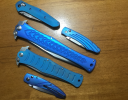I'm not sure if this makes me feel better or not lol. I have a favored crossbar lock folder with a petite stop pin which bugs me (why use such a petite pin when you've got such a strong lock).... but when I think about it, you're right.
In the same way it's difficult to snap a really small stick in half vs a long one, that pin will probably hold up to a lot of force.... whereas the longer blade might snap.
But I also consider liner locks with stop pins and I wonder how the force would be dispersed between the two (in a stabbing motion). It feels like the liner would fail before the blade snapped but I could be completely wrong.
As stupid as it sounds, one of the reasons I carry a 3.5" to 4" folder is self defense. Not just for humans but dogs too lol. I've gotten pretty weird about inspecting the cutout for the pivot, as well as how the radii are cut for whatever locking mechanism/stop pin. That area seams like a possible weak failure point but I never considered other parts of the blade snapping.
It would really bum me out to have to carry a fixed blade but damn... might have to start

Are you the one who makes folders with
really beefy liner locks? I saw some pics from a maker here who did custom folders with the most appropriate liners I've ever seen.

